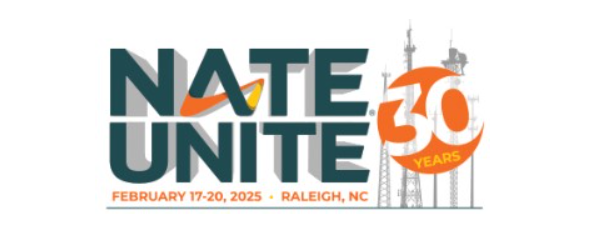As NATE prepares for its upcoming NATE UNITE 2025 conference and trade show in Raleigh, NC next week, Inside Towers asked them to reflect on the countless lessons about the complexities of event planning they’ve learned over the years. Paula Nurnberg, NATE COO; Shari Wirkus, Events and Meetings Manager and Nikki Gronau, Director of Operations all contributed their thoughts. (See Part One from yesterday’s issue)
- (see parts 1-thru-4 in yesterday’s issue) Event Scheduling
Event scheduling is a critical aspect to manage, Gronau said. The timing of Board, committee, and business meetings, exhibitor setup, keynote speakers, breakout sessions, networking events, and attendee engagement opportunities must be carefully coordinated to ensure the event flows seamlessly. “To avoid bottlenecks,” she said, “we build in buffer times, when possible, between events to allow ample time for setup, breakdown, and unexpected delays. A well-organized timeline ensures that the event stays on track while offering attendees a structured and enjoyable experience. Clear communication and strategic planning ensure that the event runs as smoothly as possible.”
- Flexibility and Contingency Planning
No matter how much planning is involved, according to Nurnberg, some aspects of conferences and trade shows are unpredictable. From last-minute speaker, attendee, and exhibitor cancellations to unexpected shipping or weather delays, to technical issues, flexibility is crucial.
“One year, we had to scramble when a keynote speaker cancelled just a couple of weeks before the event,” she said.”Thankfully, our dedicated staff and strong network of volunteers quickly collaborated to find a replacement and adjust the schedule on the fly. We have continued to be flexible and adept at managing these kinds of contingency plans to ensure the show goes on as seamlessly as possible.”
- Food and Beverage
Events and Meetings Manager Wirkus cited catering as another often-overlooked aspect of event planning that can quickly spiral into challenges. “We have learned from past events that providing enough food options for everyone is key to attendee satisfaction,” she said, “especially when the event spans multiple hours or even days. We collaborate closely with our catering partners to create multiple food stations and offer diverse menu options, ensuring everyone’s needs are met.”
- Association and Event Growth
Over time, both the association and the event itself have experienced ebbs and flows in attendance and overall growth. When the event grows, there is an inevitable challenge of scaling logistics, attracting new exhibitors, and ensuring the event stays fresh. Show planners have learned that staying attuned to industry trends and attendee needs is vital to keeping the event relevant. Several years ago, NATE as an association rebranded and expanded its reach to include new and additional industry sectors which has also expanded the annual conference and exposition focus to include new sectors. Volunteers are closely connected to the industry and play a vital role in helping them to stay in tune with these changes and adapt accordingly.
- Finding the Right Venue and Service Partners
Selecting the right venue and event service partners is foundational to creating a successful conference and trade show, the planner agreed. In the past, they have experienced both triumphs and challenges in securing the best venue and service partners.
“Our experiences have taught us to vet every partner carefully and build strong relationships with both services partners and venues that align with our goals,” Nurnberg said. “We have a well-established set of service providers that we have built relationships with, including areas such as exposition planning, venue research, negotiations and selection, housing and room block management, advance and onsite registration, graphic design, and more.”
- Communication and Staffing
Director of Operations Gronau said clear communication with staff, exhibitors, and attendees is one of the most critical components of a successful trade show.
“Our experience has taught us that if there is any breakdown in communication – whether it is regarding session timings, schedule in general, or exhibitor needs – it can create confusion that impacts the entire event,” she said. “To avoid this, we have built systems for consistent communication pre, during, and post-event. The efficiency and commitment of our staff and volunteers play a key role in this smooth operation.”
Conclusion: The Role of Volunteers
Through each of these challenges, the association’s staff, network of volunteers, and members, including the Board of Directors and Trade Show Committee, continue to be an invaluable resource, the show planners said.
“Their passion, dedication, and expertise are what allow us to overcome obstacles year after year. With clear communication, strategic planning, and the flexibility to pivot as needed, we are confident that this year’s conference and trade show will once again exceed expectations and continue to grow in ways that benefit our exhibitors, sponsors, and attendees alike,” Nurnberg said.





Reader Interactions